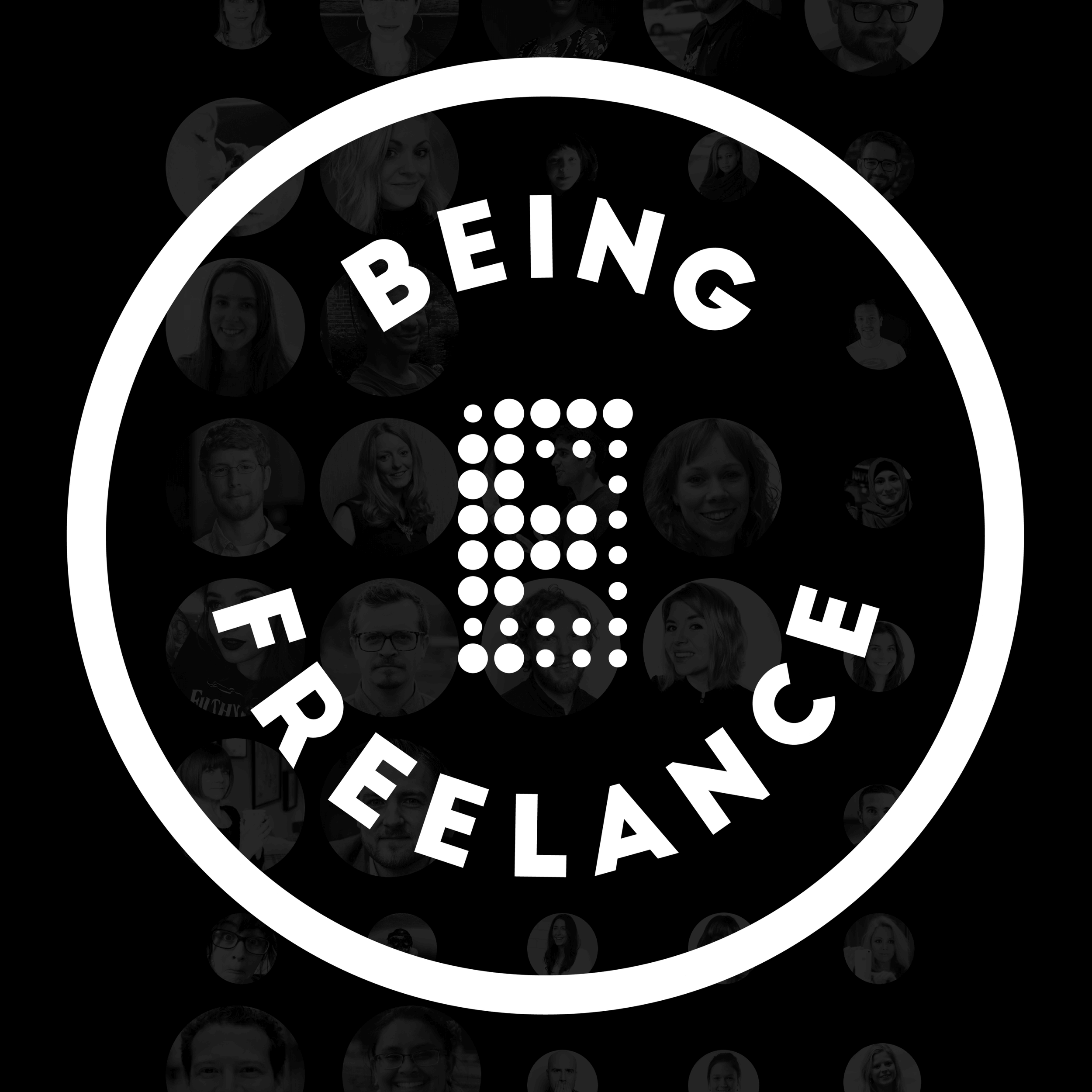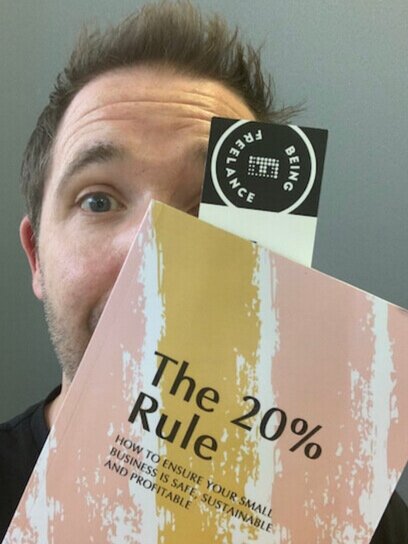Book Club: The 20% Rule, by Catherine Gladwyn
This time from the Being Freelance Book Club, a review of The 20% Rule by Catherine Gladwyn, who mentors virtual assistants and business owners.
After her own business survived without her — and with no loss of income — when she took four months off after neurosurgery, Catherine took pen to paper once more to write this, her second book.
In it, she promises to help you ensure that your business is safe, sustainable and profitable.
The Being Freelance Book Club reviewS The 20% Rule, by Catherine Gladwyn
We found the book to be a light, accessible read, practical and with plenty of humour that made it snappy. It felt conversational, like advice from a freelance friend.
Because the title is The 20% Rule, Jo said she was expecting a big thesis, similar to our first book club read, The 12-Week Year.
Jo continued: “This book was a lot better. I’ve got tons of one-liners written down that I’ve taken away from it.”
Katy agreed: “It didn’t really feel like a book. It was more like a collection of thoughts, and they were useful thoughts, but I wanted more detail on ‘The 20%’ stuff.”
Richard pointed out that “Catherine Gladwyn’s Freelancing Advice” wouldn’t have made a catchy title 😆.
Catherine’s 20% Rule says that “no one client should take up more than 20% of your time - or your income” if you want to be safe, sustainable and profitable.
Which is clearly sound advice. But the whole book takes its title from just six pages of idea.
The subtitle, How to ensure your small business is safe, sustainable and profitable, does the book more justice. In that way, it felt similar to Survival Skills for Freelancers, which we read last time.
But maybe “20%” is something to work towards rather than something you can begin freelancing with: “If you take the title literally,” said Jo, “and you’re just starting out, that could be really off-putting. I had to think about how that would apply to my business because I only work with about three or four clients a year. So for me, it’s more about the time and diversification in other ways.”
The 20% Rule served as a welcome reminder that we have more stability than most as freelancers, with multiple clients and options.
Scott explained: “When I started my freelancing career, I was talking with my wife about job security. I realised that actually, I have many small clients and I’d have to piss off everyone at the exact same time in order to “lose my job.” Before, with only one employer, only one thing had to go wrong for me to lose my job.”
Outsourcing and admin
Steve pointed out that Catherine’s philosophy around outsourcing is that you should almost be able to hand your business over to someone who you might think of as a competitor, so that if you were to go out of action for six months, your business would keep going.
Could we go that far?!
Katy said the book did make her think about developing her systems so that it’d be easier to hand them over in case she was unable to work for a while.
Luke enjoyed the outsourcing exercise that encourages you to think about what you can’t / won’t / shouldn’t do yourself in your business. “It made me think about what I could possibly hand over to someone else.”
Katy has a VA for a few regular tasks but she doesn’t hand work over to her often. She says that her brand is built around her own personality. It’s woven into all parts of the business and so it’s hard to pass that over to anyone else.
Jo’s outsourced various things, including website copy and graphic design, and she’s partnering with other freelancers on projects too. She has ideas for outsourcing more in her business but she’s taking the time to figure out what makes sense and in what order it should happen.
Marketing, pricing and clients
Vic appreciated the tips around raising prices. The book includes sample emails that Luke described as “shameless, brave ways of just happily announcing it, rather than hiding your eyes and questioning whether it’s okay.”
Another great statement was around keeping your prices at a good level so that you don’t drag everyone else down.
The 20% Rule goes into specific detail about how to do certain things, like develop packages, which we haven’t seen in other books yet. We appreciated its inclusion even if we didn’t always agree with the advice.
In the book, Catherine advises against using customer avatar or client personas and says you should focus on your skill instead — promote your skills and then the people who need them will find you. We didn’t all agree with this advice.
“One of the things Catherine said that I really liked,” Katy said, “was to make sure that your name is out there and you’re known for doing your thing. Part of that is ‘I do X for Y’. That’s a big part of being known for something.”
Richard wondered whether Catherine meant that it isn’t necessary to go into too much detail with questions like what kind of shoes potential clients wear or where they shop. “But there’s a lot to be said for knowing your niche and knowing what you do,” he added.
Luke said that the marketing tips hit home for him as an introvert. “It’s awkward and annoying to have to say ‘Hello, I do this thing and you should pay me to do it,’ all the time. So statements like ‘You’re your own worst enemy if you’re not always telling people what you do’ helped. I made a lot of notes with my head hung in shame.”
So what do we think? Should you buy the book?
Overall, we felt the book raised an important question for freelancers to consider how their business would keep going should a personal life/health crisis (or global pandemic!) get in the way. It’s more than likely to happen to us at some point, so best to plan ahead.
If anything we would have loved more of Catherine’s own personal story - it’s what she’s got to share that’s unique to other business books.
Richard said he’ll keep it on his shelf and reference it when he’s struggling with something and looking for examples.
And since the book is very well indexed, it’s easy to jump back in and catch Catherine’s thoughts on particular topics.
It wasn’t a book we’d necessarily all recommend, but undoubtedly as with Survival Skills from last time if you put the advice into action, you could gain a lot of value from it whatever the future may hold.
Thanks so much to these BFFs for turning up and sharing their thoughts on the book!
Scott Ellis, Freelance English Teacher
Vic Giménez, Freelance Copywriter and Transcreator
Jo Gordon, Marketing Consultant, Data and Analyst specialist
Katy Carlisle, Squarespace Designer and Trainer
Luke Johnson, UX Consultant, Service Designer, System Author
Richard Berks, Science writer for charities
Previously in the book club:
Survival Skills for Freelancers, by Sarah Townsend (highlights here)
Hype Yourself, by Lucy Werner (highlights here)
Company of One, by Paul Jarvis (highlights here)
The 12-Week Year, by Brian P. Moran and Michael Lennington (highlights here).
(The links to books on this page are affiliate. If you click one and purchase within 24 hours, some pennies come in to help keep Being Freelance in biscuits. Thanks for the support!)



